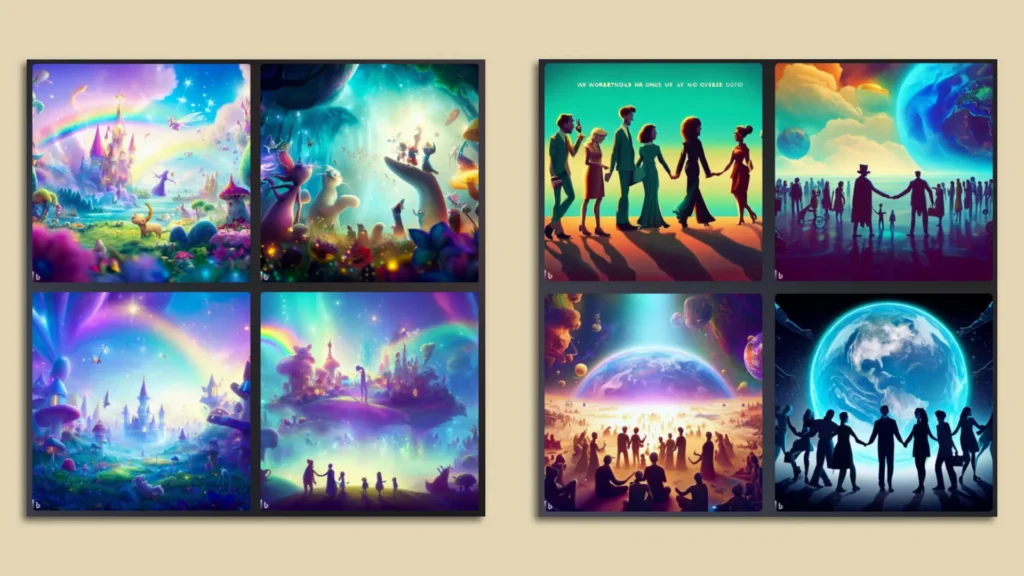Bing AI Image Creator 3D

The intersection of artificial intelligence (AI) and digital art has introduced groundbreaking innovations, and one of the most exciting recent developments is the Bing AI Image Creator.
Powered by OpenAI’s DALL·E 2 model, this tool allows users to generate high-quality, customizable images from text prompts. However, one area that is gaining considerable attention is the extension of AI-generated image creation into 3D art.
Bing AI Image Creator 3D offers a glimpse into the future of creative expression by providing users with a tool that not only generates stunning 2D images but can also explore the third dimension.
In this article, we will explore the functionality of Bing AI Image Creator 3D, its potential uses, and how it could change the way we create digital content.
What is Bing AI Image Creator 3D?
Bing AI Image Creator 3D takes the AI-driven image generation concept to a new level by enabling users to create three-dimensional images or models based on text descriptions.
While traditional AI tools have been adept at generating stunning 2D images, adding the 3D dimension opens up exciting new possibilities for design, art, gaming, education, and more.
Essentially, the Bing AI Image Creator 3D integrates the same principles of text-to-image generation but includes the depth, perspective, and intricate design required for three-dimensional objects.
This tool combines Bing’s AI-powered text generation capabilities with 3D modeling and rendering techniques, providing a unique opportunity for creators to produce 3D art without the need for advanced 3D software or technical expertise.
By typing in descriptive prompts, users can generate detailed 3D models, objects, and scenes that can be viewed and interacted with in three dimensions.
How Does Bing AI Image Creator 3D Work?
Just like its 2D counterpart, Bing AI Image Creator 3D relies on advanced AI and machine learning algorithms to process natural language input and convert it into a visual output. Here’s a breakdown of how the process works:
- Inputting a Text Prompt: To start using the Bing AI Image Creator 3D, users need to input a descriptive text prompt. For instance, a user could request a 3D model of a “floating island with waterfalls and lush greenery.” The AI interprets this prompt and processes the keywords, such as “floating island,” “waterfalls,” and “lush greenery,” to construct the 3D scene accordingly.
- AI Processing and Model Generation: The AI then analyzes the input text, drawing from its extensive dataset to understand the objects and elements involved. The model is trained to recognize both the physical and conceptual aspects of the objects it’s being asked to create. It constructs the 3D model by adding depth, lighting, and texture.
- 3D Model Creation: The output is a three-dimensional object or scene. Users can rotate, zoom, and interact with the 3D model in real-time, seeing all sides and angles of the object as it would appear in the real world. This capability is crucial for industries that rely on visualizing products, environments, or concepts in three dimensions.
- Refining and Customizing: After the initial model is generated, users can adjust the description to refine the output. For example, if the user wants the island to have more specific features, like a castle or specific tree types, they can modify the prompt, and the AI will update the model accordingly.
- Exporting the Model: Once satisfied with the 3D model, users can download or share it. The model can be exported in various formats, making it suitable for use in 3D animation, virtual reality (VR), augmented reality (AR), gaming, and product design applications.
Key Features of Bing AI Image Creator 3D
The Bing AI Image Creator 3D offers several innovative features that differentiate it from traditional design tools and enhance its versatility for various industries:
1. Text-to-3D Capabilities
The primary feature of this tool is its ability to convert text descriptions into 3D models. Users do not need to have any experience in 3D modeling or design to create professional-level 3D objects. This functionality allows anyone—from novice creators to professional designers—to bring their ideas to life in three dimensions with ease.
2. Real-Time 3D Interaction
Unlike traditional image generation tools, Bing AI Image Creator 3D allows users to interact with the generated models in real-time. Users can zoom in and out, rotate, and manipulate the model to see it from different angles. This feature makes it easier to evaluate the model’s proportions, textures, and details.
3. Versatility in Output
Bing AI Image Creator can generate 3D models for a wide variety of industries. Whether you’re creating game assets, product prototypes, architectural designs, or fantasy worlds for storytelling, the platform supports diverse use cases. This adaptability opens up new possibilities for different creative disciplines.
4. High-Quality Models and Textures
Bing’s AI has been trained on an extensive dataset, allowing it to produce high-quality 3D models with realistic textures, shadows, and lighting effects. The AI’s understanding of the real world ensures that objects in the generated models adhere to principles of physics and design, creating lifelike and believable objects.
5. No Need for Specialized Software
Bing AI Image Creator 3D eliminates the need for expensive 3D design software or technical skills. This feature is especially useful for users who want to create 3D models without having to invest in tools like Blender, Autodesk Maya, or ZBrush.
6. Collaboration and Sharing
Once a 3D model is created, users can easily share their creations with others. Whether sharing a model for feedback, incorporating it into a project, or simply showcasing it, Bing AI Image Creator 3D enables seamless collaboration.
Applications of Bing AI Image Creator 3D
The introduction of 3D AI-powered image creation has unlocked numerous possibilities across various industries. Let’s examine some of the key fields where Bing AI Image Creator 3D can have a significant impact:
1. Gaming
In the gaming industry, the need for high-quality 3D assets is constant. Developers and designers often need to create vast landscapes, intricate characters, and complex objects to populate their game worlds. Bing AI Image Creator 3D can generate these assets quickly, saving time and resources in the game design process. Additionally, the ability to instantly preview and refine 3D models means designers can quickly iterate on their concepts and enhance the game’s visual appeal.
2. Product Design and Prototyping
In the product design space, companies can use AI-generated 3D models to visualize new concepts before producing prototypes. For example, a furniture designer might input a prompt like “modern armchair with a metal frame and a velvet cushion” and receive a detailed 3D representation. Designers can then tweak the product’s design before moving to physical prototypes, significantly reducing development costs and time.
3. Architecture and Interior Design
In architecture and interior design, Bing AI Image Creator 3D can be a game-changer. Architects can use it to quickly generate and visualize building exteriors, interiors, and landscapes based on their descriptions. It can help them evaluate different design concepts, plan layouts, and present ideas to clients without investing in extensive CAD software.
4. Education and E-Learning
Educators can use 3D models generated by Bing AI Image Creator 3D to bring lessons to life. Visualizing complex scientific concepts, historical monuments, or artistic designs can enhance learning experiences. For example, teachers can create a 3D model of the solar system, ancient architecture, or a human cell for use in classrooms or virtual lessons.
5. Virtual Reality and Augmented Reality
The integration of AI-generated 3D models in virtual reality (VR) and augmented reality (AR) offers an exciting frontier. The ability to create dynamic 3D environments for VR simulations or AR applications can transform industries such as entertainment, education, and real estate. Users can visualize digital objects in their physical space using AR or immerse themselves in fully interactive VR worlds.
6. Digital Art and Creativity
Artists and creators can leverage Bing AI Image Creator 3D to explore new forms of digital expression. Whether it’s crafting virtual sculptures, immersive environments, or fantastical landscapes, the tool enables creators to experiment and develop unique visual pieces. With no need for technical 3D modeling skills, artists are free to focus entirely on their creative process.
Benefits of Bing AI Image Creator 3D
There are several advantages to using Bing AI Image Creator 3D, particularly for those who may not have the time, resources, or skills to create 3D art through traditional methods:
- Accessibility: The platform is free and easy to use, making 3D creation accessible to anyone, regardless of their experience level or background.
- Time Efficiency: Instead of spending hours designing complex 3D models, users can quickly generate the desired images with just a few simple text prompts.
- Cost Savings: The free nature of the platform eliminates the need for expensive software or hiring 3D design experts, offering a budget-friendly solution.
- Instant Feedback and Iteration: The ability to tweak and adjust prompts and see the changes in real-time allows for quick iterations and refining of the design.
- Creative Freedom: With Bing AI Image Creator 3D, creators are not restricted by technical limitations but can focus purely on their vision.
Limitations and Challenges
While the potential of Bing AI Image Creator 3D is vast, there are certain limitations that users should be aware of:
- Quality Control: Although the tool can generate high-quality models, it may struggle with complex or highly detailed prompts that require nuanced interpretation.
- Resolution: The output may not always match the resolution or level of detail required for professional-grade 3D work, especially for large-scale projects or high-end production.
- Creativity Boundaries: The AI is still learning and may not fully capture highly creative or abstract ideas. Users may need to experiment with prompts to achieve the desired results.
Conclusion
Bing AI Image Creator 3D is a revolutionary tool that democratizes access to 3D model creation. By combining the power of OpenAI’s DALL·E 2 with cutting-edge 3D modeling techniques, the platform allows users to bring their creative visions to life without the need for advanced technical skills.
Its applications span a wide range of industries, from gaming to architecture to education, providing both professionals and casual creators with an invaluable tool for visualizing concepts and bringing ideas to life in three dimensions.
As the technology behind AI continues to evolve, we can expect Bing AI Image Creator 3D to become even more sophisticated, offering even more advanced features for those looking to create stunning 3D artwork, prototypes, and designs.
For anyone looking to explore the exciting world of AI-generated 3D art, Bing AI Image Creator 3D is an accessible, powerful, and creative tool that unlocks a world of possibilities.






Responses